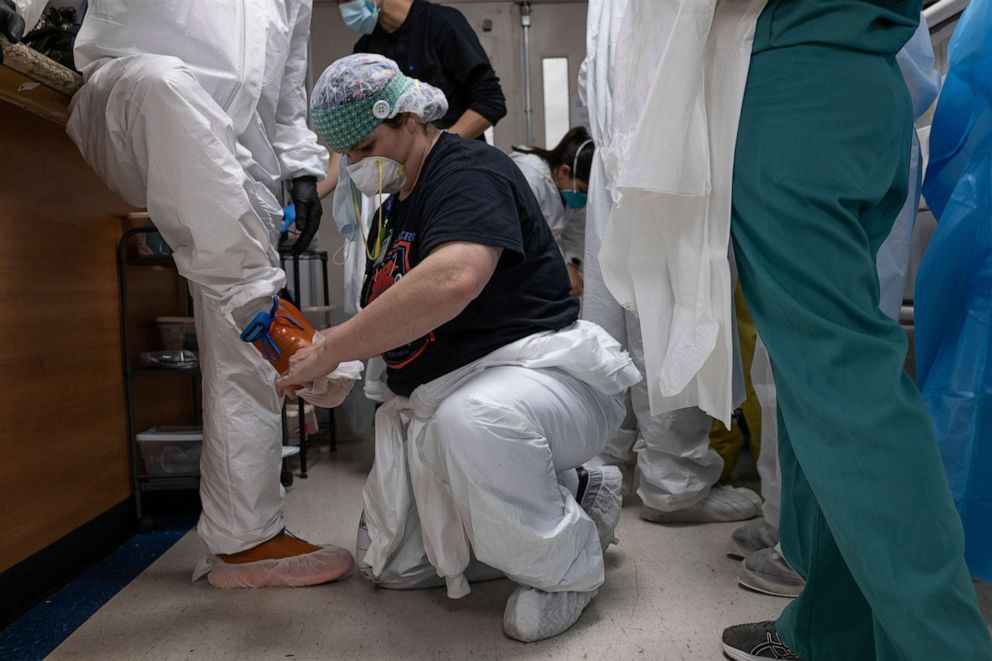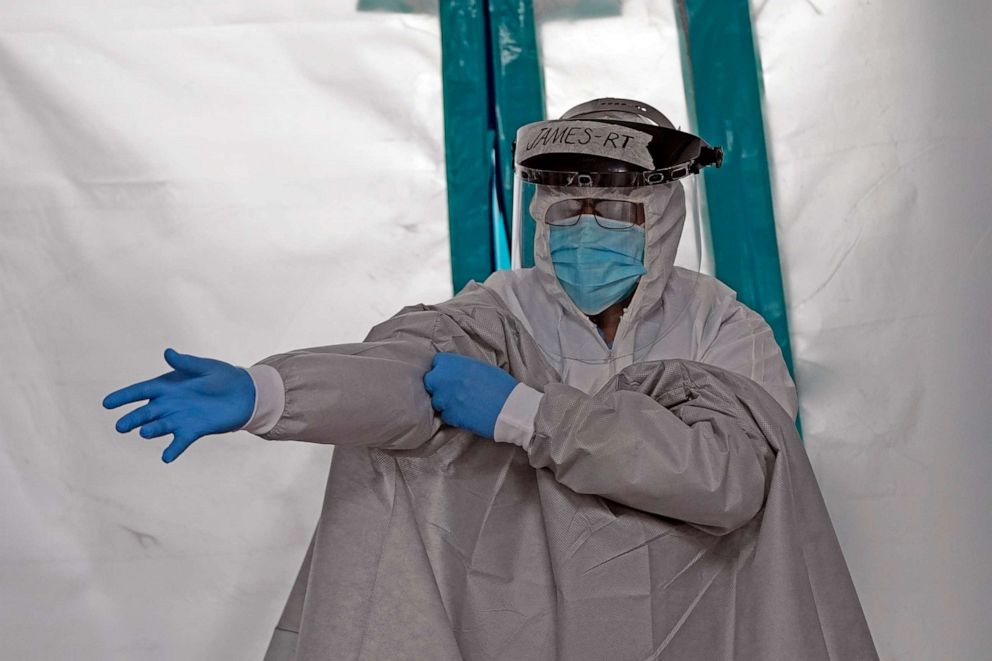Doctors, nurses warn of another protective gear shortage as coronavirus surges
"I just cannot believe that we're in this situation again," doctor says.
Dr. Sandra Fryhofer had so much trouble finding surgical gowns and masks for her Atlanta office several weeks ago that she said she was forced to rely on her patients for help.
"One of my patients had a friend who lives in China, so early on, she sent me 30 masks," Fryhofer told ABC News. "When I got them, I just cried because there was a time that I didn’t have anything to offer my staff."
Now in July, as coronavirus cases rise in Georgia and 38 other states and some set hospitalization records, Fryhofer said she's still struggling to provide protective equipment for her staff -- and she's not alone. Front-line medical workers and doctors in private practice are again sounding the alarm over ongoing shortages of protective gear, as they are forced to burn through supplies to treat the growing number of infected patients.

Months after some New York City nurses were forced to wear garbage bags for protection, the shortage of protective gear impacting rural and urban hospitals, nursing homes and private physicians' offices is one of several problems with the nation's pandemic response that have resurfaced again, along with delays in testing and crowded hospitals in several regions.
“I just cannot believe that we are in this situation again,” said Dr. Leana Wen, an emergency physician and public health professor at George Washington University, who previously served as Baltimore's Health Commissioner. “It’s because of failure of planning and anticipation.”
In interviews with ABC News, nurses, doctors and health care supply chain experts blamed the scarcity of masks, gowns and gloves on the Trump administration’s decision not to centralize and coordinate the purchase of protective gear, which has forced states and hospitals to bid against each other.
“Everybody thought it was kind of solved, but it really hasn't been,” Deborah Burger, the president of National Nurses United, told ABC News.
They also expressed frustration with the lack of transparency with the state of the supply chain, and President Trump’s refusal to leverage the Defense Production Act to compel producers to scale up operations to prepare for the resurgence of the virus.

In response to ABC News' questions, a spokesperson for the Federal Emergency Management Agency, which leads the federal government's supply efforts, said it is working with states and partners to obtain more protective gear, and pointed to the prior delivery of tens of millions of pieces of personal protective equipment, known as PPE, to the nation's health care facilities.
But despite the delivery of protective equipment to the states, an internal administration document obtained by ABC News suggests that the federal government has yet to meet the demand for millions more of pieces of gear.
The internal administration briefing prepared for senior leadership of FEMA and Department of Health and Human Services on July 10 noted that the administration had only supplied 29% of surgical gowns, 30% of gloves and 4% of boot coverings requested by states and territories.
The document also stated that the administration had delivered roughly 40% of the nearly 176,000 body bags requested by the states and territories. FEMA declined to comment on the document.
Survey: Most nurses re-using "single-use" masks
In June, NNU, the nation’s largest nursing union, released a survey of 23,000 nurses that found 87% of respondents were forced to reuse single-use disposable N95 masks with COVID patients.
Burger, who also works in California’s Sonoma County, said the limited supply of masks on the market has led hospitals to ration the gear distributed to staff, forcing many to reuse old masks and gowns longer than recommended.
“In a country that's this rich with resources, it seems criminal that nurses, and health care workers are having to make do with garbage bags and other cobbled together, non-certified, safe equipment,” Burger told ABC News.
Guy Sneed, the division chief medical officer for Hillcrest Healthcare System in Oklahoma, told ABC News that his system has been reprocessing N95 masks since April, which will allow some masks to be used as many as 10 times if needed.
Dr. Michael Seemuller, the Chair of Quality and Safety for AnMed Health Physician Network in South Carolina, told ABC News that it's "impossible to predict how long our PPE will last."
"We are running out of medically-fit N-95 masks that are the most snug, so we have to rely on N-95 masks that may not always fit the wearer," Seemuller told ABC News.
The supply problem can extend well beyond large, well-known hospitals and into private practices that dot the nation and serve millions of Americans, according to Dr. Susan Bailey, a Fort-Worth based immunologist and president of the American Medical Association.
“Most physicians’ practices didn't use PPE at all before the pandemic or just to a very limited extent,” she said. “They have no supply chain. They have no regular supplier. There are doctors going to Amazon, to try, to find, to buy masks.”
Pleas for help, and transparency, from the government
At the end of last month -- nearly four months after the first coronavirus case was reported in the U.S. -- the AMA asked the Federal Emergency Management Agency to be more transparent about the protective gear supply chain and where the problems still exist.
“A significant obstacle to crafting effective solutions has been the lack of data to help us ascertain whether the central problem is in the availability of raw material, production backlogs, gaps in the distribution systems, or some combination of all three,” the group recently wrote to FEMA Administrator Peter Gaynor.
The organization also wrote to Vice President Mike Pence, requesting the administration leverage the Defense Production Act to ramp up production of both N95 masks and gowns.
The administration has repeatedly invoked the act to spur the production of ventilators and testing supplies -- and also used it in April to order more than 160 million N95 masks from 3M. But critics and experts said the Trump administration could leverage its authorities under the act more aggressively to address the protective gear shortages.
While Congress appropriated $1 billion in March for the production of testing and medical supplies under the Defense Production Act, the administration has used only $212 million on medical supplies, Democrats wrote on Tuesday.
"We are concerned that the Administration has not allocated sufficient funds to boost short-term and longterm domestic production of critical medical supplies and equipment to meet the overall public health needs of the United States," a group of House Democratic committee chairs wrote to the Secretaries of Defense and Health and Human Services on Tuesday, seeking information about plans to boost medical supplies.
The White House declined to comment on the record about the use of the Defense Production Act.
Last week Pence appeared to paint a rosier picture of the PPE situation, saying at a coronavirus briefing that "PPE, we hear, remains very strong." But the vice president did say they were "encouraging health care workers to begin now to use some of the best practices that we learned in other parts of the country to preserve and to reuse the PPE supplies."
The White House's response to the supply chain problems, including the now-shuttered Project Airbridge effort to airlift supplies earlier in the crisis, has already come under scrutiny from Democratic lawmakers.
Earlier this month, Democrats on the House Oversight Committee released a report on Airbridge that concluded the federal government failed to provide guidance to private sector partners on distribution and shortages, resulting in a chaotic free-for-all on the global PPE market between states.
Representatives for some of the country’s largest medical supply distributors that participated in the initiative raised concerns about the price and supply of raw materials used to manufacture protective gear, which could make their work unsustainable, the report said.
Rear Adm. John Polowczyk, who leads the White House Supply Chain Task Force, told lawmakers that 70 to 75% of states had at least 30 to 60 days of protective gear in reserve, and suggested that concerns from some medical workers did not comport with the federal government’s data. He also said the federal government still lacked some state-level data on N95 and PPE supplies.
A FEMA document of projected supplies and demands for protective gear -- separate from the one obtained by ABC News and made public by the agency at the urging of Sen. Maggie Hassan, D-N.H. -- said that the demand for gowns “outpaces current US manufacturing capabilities,” and that there is no U.S.-based manufacturing for synthetic rubber gloves.
FEMA touts PPE figures in the millions, but the problem could be in the billions
In a statement to ABC News on Tuesday, FEMA said, “The Supply Chain Stabilization team is continually working with interagency partners to increase domestic manufacturing of PPE. Demand is overtaking supply because hospitals, states, and the federal government are stockpiling PPE.”
“As of July 14th, FEMA and HHS have coordinated the delivery of, or are currently shipping: 103.1 million N95 respirators, 159.3 million surgical masks, 17.2 million face shields, 74.5 million surgical gowns/coveralls, 139.4 million gloves, 34.2 million KN95 respirators, 13.8 million KN90 masks and 2.4 million thermometers,” the agency said in a statement.
Hospital workers and nurses say it hasn't been enough.
Get Us PPE, a nonprofit that delivers protective gear to front-line workers, has seen a 200% increase in requests from Florida, Arizona and Texas since May – with a majority coming from rural hospitals and nursing homes, rather than large hospital systems.
“The denominator of hospitals and facilities who need this continues to grow,” said Dr. Ali Raja, a co-founder of the organization and executive vice chair of the Department of Emergency Medicine at Mass General Hospital. “Even if supply is picking up, it has in no way met demand.”
In March, Dr. Robert Kadlec, the assistant secretary for preparedness and response at HHS, told lawmakers that the country would need 3.5 billion single-use N95 masks for the pandemic, and had less than 1% in the national stockpile at the time.
But that estimate may have been low, Prakash Mirchandani, the Director of the Center for Supply Chain Management at the University of Pittsburgh, told ABC News, pointing to the need for similar protections in nursing homes and other non-hospital medical facilities.
“If you would have asked me one year ago whether that would happen in the U.S., I would have said zero chance,” he said of the supply chain shortages. “In a country which really values research and a great health care system, it’s happening, unfortunately."
ABC News' Olivia Rubin contributed to this report.
What to know about coronavirus:
- How it started and how to protect yourself: Coronavirus explained
- What to do if you have symptoms: Coronavirus symptoms
- Tracking the spread in the U.S. and worldwide: Coronavirus map




